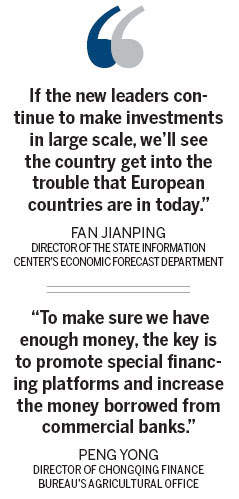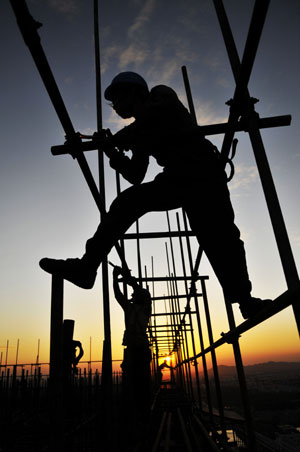Will fresh stimulus cash spur growth?
Updated: 2012-01-12 10:44
By Chen Jia and Wei Tian (China Daily)
|
||||||||
With vow to keep spending on roads, railways and west, investment may be a key driving force
CHONGQING / BEIJING - From the top of a 400-meter-high artificial hill in Hong En Si Park, visitors can see across the Yangtze River to the hundreds of bulldozers clearing the way for new buildings in the concrete jungle that is Chongqing.
Construction of the 76-hectare park in this southwestern municipality was largely finished in May 2009, but workers are still on-site completing surrounding roads, while extra features such as a children's play area are still waiting for the green light.
|
|
More than 1 billion yuan ($158.3 million) has already been spent on converting the land, once home to about 380,000 people. The money has gone toward, among other things, 10,000 sweet osmanthus seedlings and a Tang Dynasty-style pavilion.
Since 2008, Chongqing has aimed to inject 48 billion yuan, about 5.8 percent of its GDP in 2010, in expanding plantation coverage and infrastructure construction by 2017, according to Ding Lirong, deputy director of the municipal finance bureau.
Local authorities had hoped such projects would increase investment and ferment GDP growth, at the same time as improving the environment.
And Chongqing is not the only place where officials have shown a great interest in stimulating economic growth with fixed-asset investment. In the first 11 months of last year, urban fixed-asset investment nationwide reached 14.51 trillion yuan, an increase of 24.5 percent on 2010, data from the National Bureau of Statistics (NBS) show.
During the annual Central Economic Work Conference last month, leaders vowed to continue leaning toward key areas such as infrastructure, railways, environmental protection, emerging industries and the development of western China in 2012, signaling that investment could still be the main driver to maintain momentum for the world's second-largest economy amid weak global economic recovery.
With the worsening eurozone debt crisis and the fact that the United States' economy is recovering slower than expected, analysts at international financial institutions have downgraded their expectations for China's economic growth this year, largely because of the sharp decline in exports during the past few months.
 |
The country's GDP growth rate may drop to 7.5 percent in the first quarter of 2012, down from the 8.3 percent predicted in the last quarter of 2011, said Stephen Green, senior economist at Standard Chartered Bank. The figure for the period July to September last year was 9.1 percent.
A research note from the Bank of Communications said that China's monetary policy may continue to loosen this year to avoid an economic "hard landing".
Lending by banks is expected to increase, with the aim to boost investment, the note said. New loans could climb to 8.5 trillion yuan, compared with 7.5 trillion yuan last year.
"If a new increase in investment (by the central government) occurs it would be appropriate, given that the external situation for China's economy is negative," John Ross, economist and a visiting professor at Shanghai Jiao Tong University, told China Daily in an e-mail. "However, a very large-scale increase in investment like the 2008 stimulus package is not called for."
Political shifts
Planning for Hong En Si Park started in July 2005. However, because of a shortage of funds, construction had to be delayed until February 2008, following a local government reshuffle.
Fan Jianping, director of the State Information Center's economic forecast department, said that the pulse of a country's economic cycle is often synchronous with its power shifts, a statement that seems to be proved right by statistics.
"The second and third year of every Five-Year Plan period, which see obvious investment booms, are also the years for Party congresses and government elections," said Fan in Beijing. "That data is often used to show the impact of power transfers on China's economic development."

 Relief reaches isolated village
Relief reaches isolated village
 Rainfall poses new threats to quake-hit region
Rainfall poses new threats to quake-hit region
 Funerals begin for Boston bombing victims
Funerals begin for Boston bombing victims
 Quake takeaway from China's Air Force
Quake takeaway from China's Air Force
 Obama celebrates young inventors at science fair
Obama celebrates young inventors at science fair
 Earth Day marked around the world
Earth Day marked around the world
 Volunteer team helping students find sense of normalcy
Volunteer team helping students find sense of normalcy
 Ethnic groups quick to join rescue efforts
Ethnic groups quick to join rescue efforts
Most Viewed
Editor's Picks

|

|

|

|

|

|
Today's Top News
Health new priority for quake zone
Xi meets US top military officer
Japan's boats driven out of Diaoyu
China mulls online shopping legislation
Bird flu death toll rises to 22
Putin appoints new ambassador to China
Japanese ships blocked from Diaoyu Islands
Inspired by Guan, more Chinese pick up golf
US Weekly

|

|







